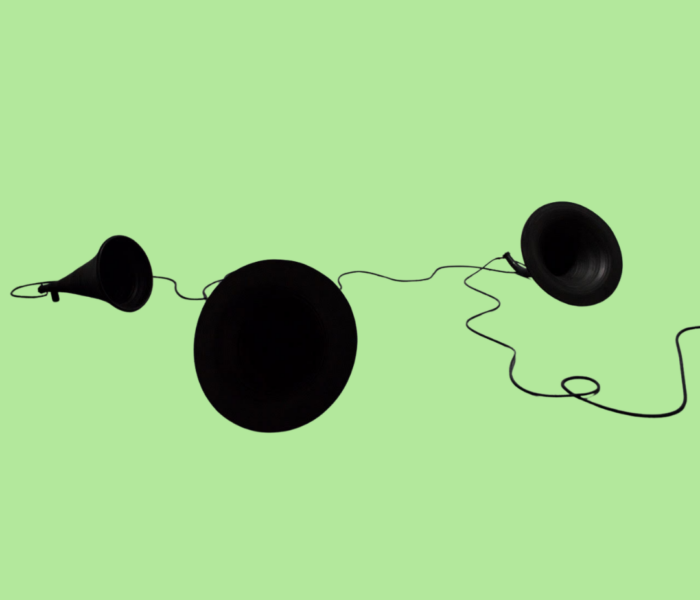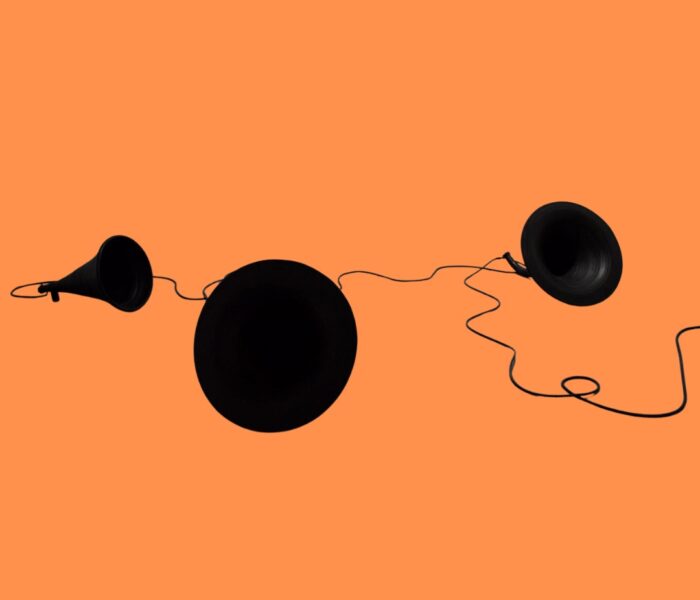Une pleine saison s’achève avec ses découvertes, ses turbulences, ses émois et ses regrets; les regrets de n’avoir pas vu plus de concerts, écouté plus de disques, des regrets de n’avoir pas fait plus attention à ce qui se jouait tout près ou ne pas avoir porté le regard plus loin que nos horizons familiers. Mais aussi et surtout, des joies et des émotions, pleines, nombreuses, inoubliables, qui nous recollent, qui nous renouent, qui nous rassemblent nous seul.es et avec les autres.
Alors voici encore et toujours de la musique pour passer l’été ensemble.
La playlist 100 % féminine de Michèle Tosi
Clara Iannotta (née en 1983) : D’après, 2012
Le piano est préparé et les accessoires sont nombreux, verres remplis d’eau, boîtes à musique, sifflets, tuyaux harmoniques mis à portée de mains des sept instrumentistes dans D’après de la compositrice italienne Clara Iannotta qui aime forger son matériau par-delà la lutherie traditionnelle. D’après est une pièce délicate, aux sonorités subtiles, qui s’inspire des sons de cloches de la Cathédrale de Fribourg-en-Brisgau. Des carillons de Clangs (sœur ainée de D’après) ne restent que les résonances assourdies, des images sonores que la mémoire se réapproprie et que l’imaginaire de la compositrice redessine.
Lara Morciano (né en 1968) : Liphyra
Liphyra de Lara Morciano est une pièce pour piano « augmenté », adoptant le format des Alla Breve/Création mondiale de France Musique. Compositrice et pianiste, Lara Morciano est une adepte de l’électronique en temps réel, attitude exploratoire qu’elle partage avec son collaborateur et RIM (réalisateur en informatique musicale) José Miguel Fernandez. Dans Liphyria, quatre transducteurs (petits micros placés dans les cordes du piano) envoient des informations à l’ordinateur qui transforme en direct le son de l’instrument et le réinjecte dans les haut-parleurs, donnant naissance à un piano virtuel, ombre double du Steinway. Les gants que Morciano revêt pour jouer sa pièce sont munis de capteurs assurant l’interaction entre le piano et la machine. Rentre en compte également l’aspect physique du jeu, sur le clavier mais aussi dans les cordes, grattées avec les ongles, balayées en glissando avec une carte plastifiée, etc. Liphyra est un papillon, insecte à métamorphose complète, qui a inspiré notre compositrice.
A écouter sur France Musique.
Claudia Jane Scroccaro (né en 1984) : I sing the body electric pour contrebasse avec Florentin Ginot et électronique (Ircam, 2020).
Claudia Jane Scrocarro est tout à la fois compositrice et réalisatrice en informatique musicale, maîtrisant elle-même le fonctionnement des outils technologiques, un domaine qu’elle enseigne aujourd’hui à l’Ircam. Dans I sing the body electric, une pièce conçue durant son année de Cursus, l’électronique va à la rencontre de la contrebasse, celle de Florentin Ginot, modelant un processus de transformation, distorsion, amplification qui donne à entendre les sons comme si l’on était à l’intérieur de la contrebasse. Cette relation fusionnelle s’affine à la faveur d’opérations effectuées par l’interprète sur son instrument qu’il désaccorde en jouant tandis que l’électronique « désaccorde l’espace », dans un glissement sensuel de fréquences aux sonorités aussi fragiles que colorées.
La playlist de l’été de David Sanson
Morton Feldman : Rothko Chapel (CD Aeon/Outhere Music, 1972)
Voilà 50 ans — le 9 avril 1972 précisément —, Rothko Chapel de Morton Feldman (1926-1987) était jouée pour la première fois dans la chapelle conçue par le peintre américain Mark Rothko à Houston. L’occasion de venir se ressourcer à cette œuvre, l’une des pièces maîtresses du compositeur. Écrite pour une soprano, une contralto, un chœur mixte, percussion, célesta et alto, cette partition à la fois statique et prodigieusement animée nous entraîne aux confins du silence et au faîte du recueillement, jusqu’à la cantilène finale, bouleversant dialogue du vibraphone et de l’alto.
Je l’ai découverte en concert il y a près de 20 ans par Les Cris de Paris et l’ensemble 2e2m, mais au disque, c’est la version enregistrée par le regretté Christophe Desjardins – avec le Collegium Novum Zurich et les Basler Madrigalisten sous la direction de Jonathan Nott – pour le label Aeon, que je privilégie.
Kali Malone : Living Torch (album Shelter Press, série « Portraits GRM », 2022 )
A 28 ans, l’Américaine Kali Malone, dont on vous parlait récemment, n’en finit pas d’affirmer sa singularité. Composé et créé au GRM à Paris, Living Torch, mêlant synthétiseurs, trombone et clarinette basse, est une plongée en deux temps au cœur du phénomène sonore : porté par des basses surhumaines, Living Torch I s’apparente à une lente ascension vers la lumière ; quant à Living Toch II, un motif de 4 notes se trouve peu à peu happé par un continuum sonore fait de fascinantes métamorphoses de textures.
Gaël Mevel : Le Cercle (CD Label Rives, 2017)
Avec 4 ans de retard, je découvre avec ravissement ce disque — dont la version CD est un étonnant objet dans une pochette peintre à la main — du violoncelliste Gaël Mevel, composé avec 6 autres muisiciens-improvisateurs hors pairs (Jacques Di Donato, Thierry Waziniak, Nicolas Nageotte, Jean-Luc Cappozzo, Diemo Schwarz et Daniel Lifermann). Enregistré en live à la Maison de la culture du Japon à Paris, les musiciens faisant cercle autour de l’auditoire (d’où le nom du projet), cette longue pièce en trois mouvements est une ode fantasmatique et zen au Pays du Soleil Levant.
Les textes de Dominique Masse et Gaël Mevel sur la page Bandcamp en parlent bien mieux que je ne saurais le faire. Mais disons que les deux dernières minutes du mouvement central, splendies et impresionnistes, résument à elle seule cette entreprise poétique qui convoque pêle-mêle, excusez du peu, « le cinéma d’Ozu, celui de Kurosawa, Bach, Debussy, la musique traditionnelle japonaise, Duke Ellington, Ravel, Gershwin, le rire de Bibi Anderson, la voix de Jeanne Moreau »…
La playlist de Sandrine Maricot Despretz
Olivier Messiaen, Vingt Regards sur l’Enfant-Jésus : Première communion de la Vierge par Bertrand Chamayou (Warner Music, 3 juin 2022)
Composé en 1944, Les Vingt regards d’Olivier Messiaen est considéré comme un chef-d’œuvre pianistique du XXe siècle qui, comme le dit Bertrand Chamayou, « sort d’un seul jet et n’a pas l’air de durer deux heures”.
Méditative et atmosphérique, la Première communion de la Vierge, 11e regards, égrène silence et résonance, et une douce mélancolie va et vient illustrant une profonde spiritualité. « Plus que dans toutes mes précédentes œuvres, j’ai recherché ici un langage d’amour mystique, à la fois varié, puissant, et tendre, parfois brutal, aux ordonnances multicolores » explique Olivier Messiaen. Enregistrée à l’Abbaye du Ronceray, dans un bâtiment datant du 11e siècle, on y voit le pianiste français avec sa partition originale sur laquelle il jouait à l’âge de neuf ans.
Clara Ysé, Le monde s’est dédoublé (EP édité chez Tomboy Lab, 2019)
A tout juste 30 ans, cette jeune chanteuse fait une entrée fulgurante sur la scène musicale avec des chansons à texte, tendance jazz et orientale, bien à elles. Formée au violon dès l’âge de 4 ans, elle est “bouleversée par les voix, par ce qu’elles révèlent des êtres” et s’initie au chant à 8 ans en écoutant en boucle celles de Maria Callas, Chavela Vargas, Mercedes Sosa, Janis Joplin ou Nina Hagen. Aujourd’hui, elle continue de chérir les voix féminines atypiques, celles qui ont l’audace d’explorer des territoires inconnus et des registres défendus. Sa voix profonde, grondante et lancinante, accompagnée à la guitare et entourée de violoncelles et de violons, nous rappelle avec plaisir, une autre grande voix, celle de Barbara.
Hania Rani, Live from Studio S2 (Gondwana Records, 2021)
Enregistré en direct dans l’emblématique Studio S2, l’un des studios d’enregistrement de la radio polonaise à Varsovie, “Il y a une sorte d’intimité quand on joue du petit piano dans cette salle immense et aussi très haute. » précise Hania Rani. Pianiste et compositrice, née à Gdansk, souvent primée, elle représente le nouveau visage de la musique polonaise, un visage que nous connaissons encore bien peu en France. Initialement inspirée par l’étude de la musique classique, elle a été initiée au jazz et à l’électronique, et comme elle le dit : « mélangeant Chopin et Schostakovitch avec Dave Brubeck et Moderat ». Live from Studio S2 est une performance minimaliste pour deux pianos proprement époustouflante.



)



